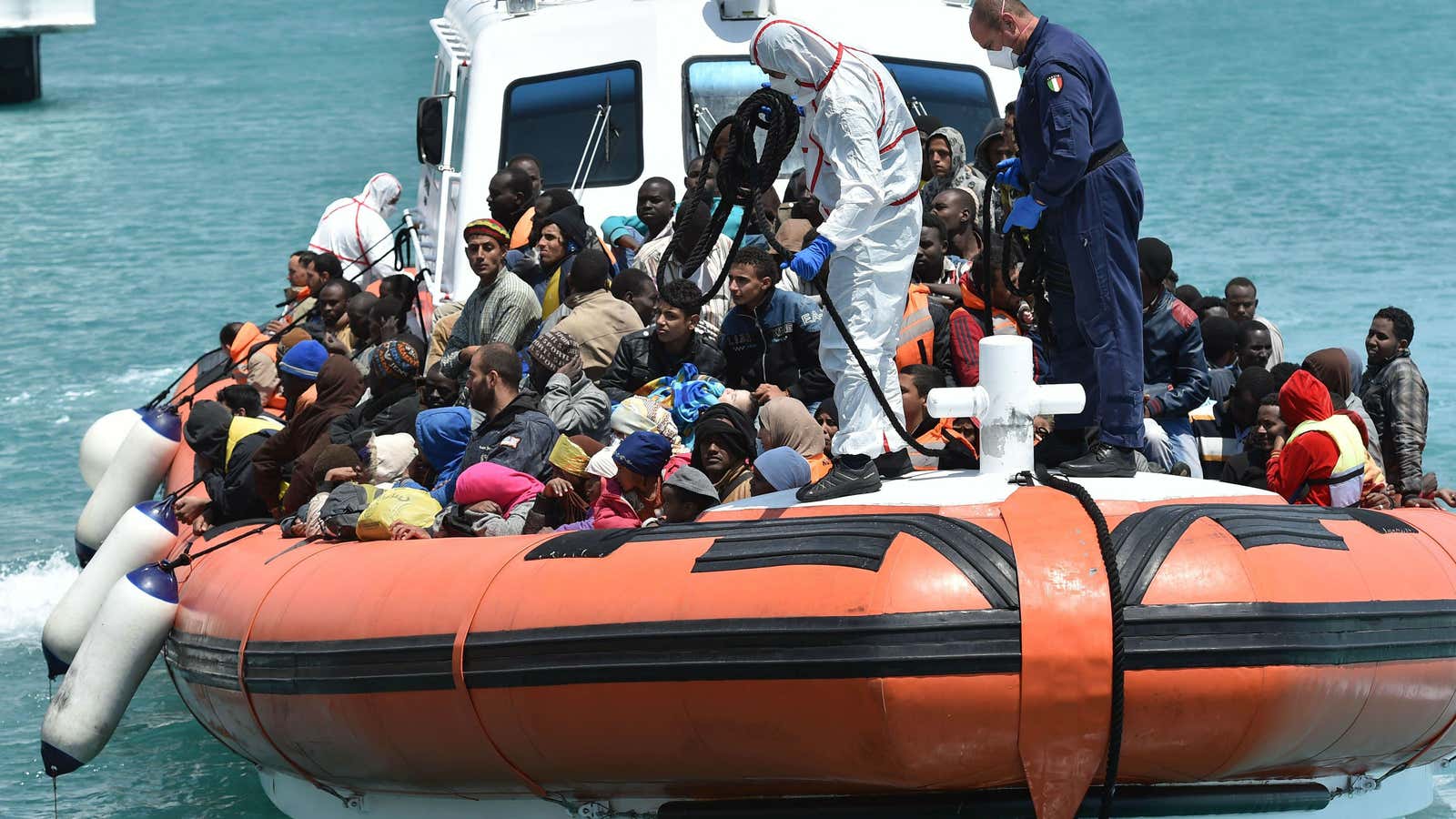They hide inside suitcases. Under the bottom of cars. Or even inside the back bumper. Hundreds of thousands of refugees have been paying thousands of dollars to cross the Mediterranean—for a trip that, they know, might end up in death. Yet, a thin chance at life somewhere else is better than the absence of a future at home.
The people crossing the Mediterranean have the desperation of those with nothing left to lose. They risk their lives in the pursuit of a fundamental human right, that “everyone has the right to life, liberty and security.”
It’s an emergency, and it has been for some time. The volume and makeup of landings on the coasts of Italy tend to derive from whatever regional crisis is happening at a given historical moment: In the early 1990s, the crossing in question was over the Adriatic sea, from the Balkans—chiefly Albania. Ships teeming with people (up to 20,000 on one) brought hoards of refugees to Italy. At the dawn of the 21st century, the influx came due to the deteriorating economic and political situation of Africa.
Behind every spike, a different issue. Famine and war in the Horn of Africa in 1999. The Arab Spring in 2011. But lately the influx has surged:

There’s no stopping the flow of migrants—certainly not with laws, nor with actions against the smugglers. This is why the European Union’s plan to focus the efforts against the smugglers, using targeted military actions to render their vessels unusable, and ramping up the scale of border patrol, appears shortsighted, not to mention inhumane.
2014 and 2015 has been unprecedented—for sheer volume of migrants, and for number of deaths at sea. In 2014, 3,419 died in the Mediterranean, on what’s been dubbed “the world’s deadliest route.” As a comparison, 2,100 people died crossing the US border into Arizona over 14 years. In 2015, by April, before the so-called “landing season” began, over 1,700 people had already died crossing the Strait of Sicily (link in Italian), in large part due to a tragic capsizing that killed 900.
The number of dead in the Mediterranean has grown not just due to an increased volume of migrants, but a decreased effort to save lives. This is particularly thanks to the end of Operation Mare Nostrum, a search-and-rescue mission led by the Italian government from October 2013 to October 2014 after the death of 366 in the Strait of Sicily, which with a budget of $9 million a month was able to save over 130,000 lives, as well as offer migrants food, shelter and support in applying for asylum.
Mare Nostrum—overwhelmingly financed by Italy—didn’t get European funding, particularly because several countries, including the UK, saw it as an aid to illegal immigration, and believed it encouraged migrants to attempt to cross the sea.
The European Commission agency Frontex instead launched Triton, an operation which became a de-facto replacement for Mare Nostrum. Triton had a much smaller budget of $3 million a month and a much different objective: Border patrol.
While Mare Nostrum’s main aim was to save people’s lives, Triton’s is to stop refugees from getting into Europe—which is why, in the case of the the capsizing that killed 900, it could do very little. In the aftermath of the tragedy, Italian prime minister Matteo Renzi appealed to the international community, asking for support for an emergency that, he rightfully pointed out, isn’t Italian but European, and ultimately global. In a op-ed in the New York Times, Renzi asked that the international community help Italy lead a larger operation—to stop the smuggling as well as rescue people at sea.
Of the two goals, it appears the European Union is only interested in the former. Their plan, modeled on counter-piracy measures which were successful in Somalia, is to stop the smugglers. Indubitably, human trafficking is a heinous crime and the perpetrators should be stopped—but the European Union seems to believe that by blocking the smugglers, the migrant crisis will solve itself. When the symptom is treated, but not the root cause, the disease often comes back, even worse.
Further, the fact that some states of the European Union (France and Spain leading the group) oppose a system that assigns a quota of immigrants to every country, in an effort to legally absorb the flow of refugees, underlines even more clearly that the aim is to keep people out rather than to save their lives.
EU high representative for foreign affairs Federica Mogherini said the initiative is a way to disrupt the smuggler’s business model:
She is correct—the smugglers’ business model does need to be undermined.
But this plan won’t do it: As long as people are desperate to leave, unscrupulous smugglers will find ways to sell them the hope of a better life—or a life, period—on the other side of the sea. Wars, poverty, and other emergencies that the international community fails to respond to will continue feeding the supply of potential refugees.
What will stop the exodus is to address the emergencies where they happen—and to create easier, legal pathways for immigration and asylum, so that there’s no demand for smugglers’ services.
That’s how to put them out of business.
No one would risk dying at sea if there is an alternative. But right now, there isn’t.
